Yu-Han Chao's Blog, page 7
March 25, 2019
4.11. DNR...
Dear Grandpa 親愛的爺爺,
Our response to the no-doubt difficult DNR decision before you is nothing but love, and great respect. You have been a role model to all of us, stern yet loving, wise but playful. You and grandma gave us the best Chinese New Year memories year after year, even now, when we return to Pingtung with children in tow, and you continue to create for us happy memories to cherish for a lifetime. We will always have the pebble-stoned beaches, the aboriginal culture museum, grandma's rice balls and pigfeet soup, all the good times--that love is forever part of us.
您一直是我們的楷模,剛毅兼關懷,智慧中帶幽默.您與阿嬤給了我們最溫馨的童年回憶,從小到大每年都如此. 如今我們帶著小朋友一起會去過年,他們也一樣有許多他們將珍惜一輩子的快樂回憶. 我們永遠都記得,在海邊玩水,原住民博物館,阿嬤美味飯糰與豬腳麵線--一切愛的片段烙在我們腦海裡.
What not even some people in our family know, is that when my mother coded in the ICU and the doctor wanted us to sign the DNR papers, a "family friend" who was not family and we barely knew, who had become a recipient of confidential information after helping translate what doctors said for my father, violated HIPAA and told everybody in my mother's (southern Californian Taiwanese) community about the DNR status being recommended.
My family and I then received call after call from complete strangers (to us) that were friends of our mother's. With no understanding of her wishes, her prognosis or the extreme measures already taken, these people pleaded with us to "give her another chance," to "please do not let her die," and so on. This made an already difficult decision and situation even harder, and certainly delayed the entire matter as well as transition to comfort care for days, during which my mother was kept at a level of sedation/anesthesia that would not have left her pain-free because she had to be checked for reflexes (which she was not displaying) and signs of improvement every few hours.
We want love, and respect, and all the best things possible for you, Grandpa. We miss you so much, all the way from California, US, to Pingtung, Taiwan. And we love you. Forever and ever.
阿公,我們愛您,也很想您,從加州一路想到屏東,直到永遠.
于涵
伊敏 敬上
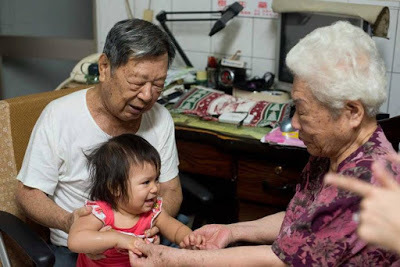
Our response to the no-doubt difficult DNR decision before you is nothing but love, and great respect. You have been a role model to all of us, stern yet loving, wise but playful. You and grandma gave us the best Chinese New Year memories year after year, even now, when we return to Pingtung with children in tow, and you continue to create for us happy memories to cherish for a lifetime. We will always have the pebble-stoned beaches, the aboriginal culture museum, grandma's rice balls and pigfeet soup, all the good times--that love is forever part of us.
您一直是我們的楷模,剛毅兼關懷,智慧中帶幽默.您與阿嬤給了我們最溫馨的童年回憶,從小到大每年都如此. 如今我們帶著小朋友一起會去過年,他們也一樣有許多他們將珍惜一輩子的快樂回憶. 我們永遠都記得,在海邊玩水,原住民博物館,阿嬤美味飯糰與豬腳麵線--一切愛的片段烙在我們腦海裡.
What not even some people in our family know, is that when my mother coded in the ICU and the doctor wanted us to sign the DNR papers, a "family friend" who was not family and we barely knew, who had become a recipient of confidential information after helping translate what doctors said for my father, violated HIPAA and told everybody in my mother's (southern Californian Taiwanese) community about the DNR status being recommended.
My family and I then received call after call from complete strangers (to us) that were friends of our mother's. With no understanding of her wishes, her prognosis or the extreme measures already taken, these people pleaded with us to "give her another chance," to "please do not let her die," and so on. This made an already difficult decision and situation even harder, and certainly delayed the entire matter as well as transition to comfort care for days, during which my mother was kept at a level of sedation/anesthesia that would not have left her pain-free because she had to be checked for reflexes (which she was not displaying) and signs of improvement every few hours.
We want love, and respect, and all the best things possible for you, Grandpa. We miss you so much, all the way from California, US, to Pingtung, Taiwan. And we love you. Forever and ever.
阿公,我們愛您,也很想您,從加州一路想到屏東,直到永遠.
于涵
伊敏 敬上

Published on March 25, 2019 00:17
4.11. Dear Grandpa...
Dear Grandpa 親愛的爺爺,
Our response to the no-doubt difficult DNR decision before you is nothing but love, and great respect. You have been a role model to all of us, stern yet loving, wise but playful. You and grandma gave us the best Chinese New Year memories year after year, even now, when we return to Pingtung with children in tow, and you continue to create for us happy memories to cherish for a lifetime. We will always have the pebble-stoned beaches, the aboriginal culture museum, grandma's rice balls and pigfeet soup, all the good times--that love is forever part of us.
您一直是我們的楷模,剛毅兼關懷,智慧中帶幽默.您與阿嬤給了我們最溫馨的童年回憶,從小到大每年都如此. 如今我們帶著小朋友一起會去過年,他們也一樣有許多他們將珍惜一輩子的快樂回憶. 我們永遠都記得,在海邊玩水,原住民博物館,阿嬤美味飯糰與豬腳麵線--一切愛的片段烙在我們腦海裡.
What not even some people in our family know, is that when my mother coded in the ICU and the doctor wanted us to sign the DNR papers, a "family friend" who was not family and we barely knew, who had become a recipient of confidential information after helping translate what doctors said for my father, violated HIPAA and told everybody in my mother's (southern Californian Taiwanese) community about the DNR status being recommended.
My family and I then received call after call from complete strangers (to us) that were friends of our mother's. With no understanding of her wishes, her prognosis or the extreme measures already taken, these people pleaded with us to "give her another chance," to "please do not let her die," and so on. This made an already difficult decision and situation even harder, and certainly delayed the entire matter as well as transition to comfort care for days, during which my mother was kept at a level of sedation/anesthesia that would not have left her pain-free because she had to be checked for reflexes (which she was not displaying) and signs of improvement every few hours.
We want love, and respect, and all the best things possible for you, Grandpa. We miss you so much, all the way from California, US, to Pingtung, Taiwan. And we love you. Forever and ever.
阿公,我們愛您,也很想您,從加州一路想到屏東,直到永遠.
于涵
伊敏 敬上

Our response to the no-doubt difficult DNR decision before you is nothing but love, and great respect. You have been a role model to all of us, stern yet loving, wise but playful. You and grandma gave us the best Chinese New Year memories year after year, even now, when we return to Pingtung with children in tow, and you continue to create for us happy memories to cherish for a lifetime. We will always have the pebble-stoned beaches, the aboriginal culture museum, grandma's rice balls and pigfeet soup, all the good times--that love is forever part of us.
您一直是我們的楷模,剛毅兼關懷,智慧中帶幽默.您與阿嬤給了我們最溫馨的童年回憶,從小到大每年都如此. 如今我們帶著小朋友一起會去過年,他們也一樣有許多他們將珍惜一輩子的快樂回憶. 我們永遠都記得,在海邊玩水,原住民博物館,阿嬤美味飯糰與豬腳麵線--一切愛的片段烙在我們腦海裡.
What not even some people in our family know, is that when my mother coded in the ICU and the doctor wanted us to sign the DNR papers, a "family friend" who was not family and we barely knew, who had become a recipient of confidential information after helping translate what doctors said for my father, violated HIPAA and told everybody in my mother's (southern Californian Taiwanese) community about the DNR status being recommended.
My family and I then received call after call from complete strangers (to us) that were friends of our mother's. With no understanding of her wishes, her prognosis or the extreme measures already taken, these people pleaded with us to "give her another chance," to "please do not let her die," and so on. This made an already difficult decision and situation even harder, and certainly delayed the entire matter as well as transition to comfort care for days, during which my mother was kept at a level of sedation/anesthesia that would not have left her pain-free because she had to be checked for reflexes (which she was not displaying) and signs of improvement every few hours.
We want love, and respect, and all the best things possible for you, Grandpa. We miss you so much, all the way from California, US, to Pingtung, Taiwan. And we love you. Forever and ever.
阿公,我們愛您,也很想您,從加州一路想到屏東,直到永遠.
于涵
伊敏 敬上

Published on March 25, 2019 00:17
March 22, 2019
4.10. PAWS = Pet-Assisted Visitation Volunteer Services
Meet Frida, the most cosmopolitan, well-read dog ever.
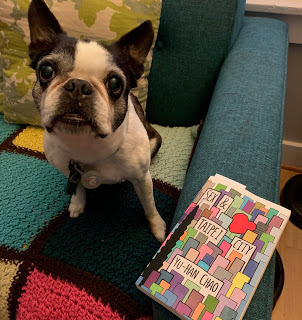 Pets provide more than entertainment, companionship or improvement in literacy (when kids read to dogs--at home or at library events). Pet therapy is an actual thing, though not in a Frida = Freudian psychoanalyst type of way. Rogerian psychiatrist, maybe:
Pets provide more than entertainment, companionship or improvement in literacy (when kids read to dogs--at home or at library events). Pet therapy is an actual thing, though not in a Frida = Freudian psychoanalyst type of way. Rogerian psychiatrist, maybe:
Human: "I'm having a bad day."
Pup, speaking with soulful eyes: "Tell me more about your bad day."
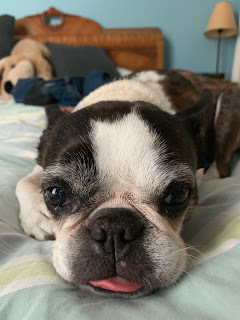 The therapeutic value of pets has been extensively studied, and evidence shows that animals can directly influence a person’s mental and physical well-being. Having a pet, or spending time with a trained "therapy pet" in a hospital, treatment center or long-term facility can decrease anxiety and enhance mood in many patients.
The therapeutic value of pets has been extensively studied, and evidence shows that animals can directly influence a person’s mental and physical well-being. Having a pet, or spending time with a trained "therapy pet" in a hospital, treatment center or long-term facility can decrease anxiety and enhance mood in many patients.
Pet therapy has proven especially effective in people receiving cancer treatment and those with anxiety, cardiovascular diseases, PTSD, dementia, or residing in long-term care facilities. The simple act of petting a cat or dog lowers blood pressure, with a decrease in systolic blood pressure of 7.1 mmHg and 8.1 mmHg in diastolic blood pressure (compared to other quiet, resting activities), according to Townsend & Morgan's Psychiatric Mental Health Nursing.
While a reasonable level of exposure to allergens and germs strengthens the immune system and decreases hyper-sensitivity reactions (e.g. allergies), hand washing before and after contact with a pet is still strongly recommended.
Though owning a pet doesn’t make one immune to illness, according to Townsend & Morgan, pet owners are statistically healthier than those who don’t own pets, with fewer minor health problems, fewer visits to the doctor, less required medications, and fewer risk factors for heart disease, such as high blood pressure or high cholesterol.
Of course, if you're not an animal person, petting Hazel may not lower your blood pressure, and having an animal is, needless to say, a tremendous responsibility, walks, vet visits and all. As with many other things in life, one must weigh all costs, benefits and cuteness.
 Meet Hazel, real life therapy Corgi.
Meet Hazel, real life therapy Corgi.
 She lives in Boston--can you tell?
She lives in Boston--can you tell?
 Pets provide more than entertainment, companionship or improvement in literacy (when kids read to dogs--at home or at library events). Pet therapy is an actual thing, though not in a Frida = Freudian psychoanalyst type of way. Rogerian psychiatrist, maybe:
Pets provide more than entertainment, companionship or improvement in literacy (when kids read to dogs--at home or at library events). Pet therapy is an actual thing, though not in a Frida = Freudian psychoanalyst type of way. Rogerian psychiatrist, maybe:Human: "I'm having a bad day."
Pup, speaking with soulful eyes: "Tell me more about your bad day."
 The therapeutic value of pets has been extensively studied, and evidence shows that animals can directly influence a person’s mental and physical well-being. Having a pet, or spending time with a trained "therapy pet" in a hospital, treatment center or long-term facility can decrease anxiety and enhance mood in many patients.
The therapeutic value of pets has been extensively studied, and evidence shows that animals can directly influence a person’s mental and physical well-being. Having a pet, or spending time with a trained "therapy pet" in a hospital, treatment center or long-term facility can decrease anxiety and enhance mood in many patients. Pet therapy has proven especially effective in people receiving cancer treatment and those with anxiety, cardiovascular diseases, PTSD, dementia, or residing in long-term care facilities. The simple act of petting a cat or dog lowers blood pressure, with a decrease in systolic blood pressure of 7.1 mmHg and 8.1 mmHg in diastolic blood pressure (compared to other quiet, resting activities), according to Townsend & Morgan's Psychiatric Mental Health Nursing.
While a reasonable level of exposure to allergens and germs strengthens the immune system and decreases hyper-sensitivity reactions (e.g. allergies), hand washing before and after contact with a pet is still strongly recommended.
Though owning a pet doesn’t make one immune to illness, according to Townsend & Morgan, pet owners are statistically healthier than those who don’t own pets, with fewer minor health problems, fewer visits to the doctor, less required medications, and fewer risk factors for heart disease, such as high blood pressure or high cholesterol.
Of course, if you're not an animal person, petting Hazel may not lower your blood pressure, and having an animal is, needless to say, a tremendous responsibility, walks, vet visits and all. As with many other things in life, one must weigh all costs, benefits and cuteness.
 Meet Hazel, real life therapy Corgi.
Meet Hazel, real life therapy Corgi. She lives in Boston--can you tell?
She lives in Boston--can you tell?
Published on March 22, 2019 12:35
March 15, 2019
4.9. SATC = Sex & Taipei City
Interviewed here by her favorite librarian, Mimi, Yu-Han Chao is the author of a new short story collection, Sex & Taipei City (available now with Red Hen Press).
 Mimi: That’s a really cute book cover. Did you draw it?
Mimi: That’s a really cute book cover. Did you draw it?
Yu-Han: Why, thank you, and yes, I did.
Mimi: Judging from the cover, these are cute stories about sex?
Yu-Han: Yes and no. The opening story is more explicit than the others, the lingering result of edits requested by a Zyzzyva editor when the story appeared in the journal. There are betel nut beauties and a grandfather obsessed with Japanese porn in the collection, but most characters are ordinary people, and the “sex” here has more to do with repression, gender concerns, failures of intimacy, and social (in)justice.
Mimi: Can you cite any direct influences or inspirations?
Yu-Han: Growing up in Taipei city in the 90s. Pai Hsien-yung (白先勇)’s Taipei People (台北人).
Mimi: So a sort of updated Taipei People?
Yu-Han: Not as up to date as it was when I first wrote it, because Taipei has changed even more now that it’s been…nearly 30 years since 1990.
Mimi: We are dinosaurs.
Yu-Han: Ammonite fossils. Taipei is more diverse than ever today, even as families and neighborhoods retain that everybody-knows-everybody’s-business type of gossipy existence.
Mimi: So your readers are getting in on some juicy gossip.
Yu-Han: In a way, yes, scandals from a whole cross section of society: schoolgirl, schoolteacher, sex worker, banker, domestic worker, foreign bride, house wife, and more.
Mimi: Any stories from real life here?
Yu-Han: Yes, actually, more than one, but with details, people, and situations changed.
Mimi: Which ones?
Yu-Han: I’ll never tell. HIPAA and everything.
Mimi: Don’t think your hospital rules apply here. Speaking of which, you’ve changed careers since graduate school. You’re a few months away from being a registered nurse? How did that come about?
Yu-Han: I took care of my mom when she was on home hospice, and it changed everything.
Mimi: Sorry for your loss. You dedicated the book to her—that means a lot, I’m sure.
Yu-Han: I would trade it all for her to be back, but I’m grateful that she helped me recognize how short life is, what matters, and inspired me to enter a profession where I can contribute more.
Mimi: Saving lives pales in comparison to Freshman English papers, for sure.
Yu-Han: They’re different. But I prefer the former now, yes. And nursing and teaching can always be combined again, in the future. Hopefully with less grading.
Mimi: Once an educator, always an educator. I see there’re even discussion questions for classrooms or book clubs at the end of the book. I'm sure all the college instructors and book club members will appreciate that.
Yu-Han: But of course!
Mimi: What are your hopes and dreams for Sex & Taipei City?
Yu-Han: I’d die of happiness if Pai Hsien-yung read it (and liked it). And Ang Li. And then maybe a movie deal, you know, the typical fiction writer’s fantasy.
Mimi: Good luck with Hollywood—you never know! You can be the next crazy rich Asian.
Yu-Han: A girl can dream. Thank you so much for the interview!
You can buy Sex & Taipei City from Red Hen Press now (with free shipping), or preorder with a deep discount* from Target or Amazon, which will ship the book 4/4/19, the official publication date.
*Actually, Target & Amazon are selling it for cheaper than the author bought her author-discount copies after accounting for shipping--not sure how they're managing that.
**Red Hen established sales requirements of 100 (or book goes out of print), 200 (or straight to the backlist it goes) the first year after publication, so any help with word of mouth/social media/marketing or sales is much appreciated!
***If you'd like to do a review or interview, invite the author to read or sign books somewhere, or want some sexy bookmarks for your class/restaurant/office, please let her know (chaoeugenia at gmail dot com)!
 Mimi: That’s a really cute book cover. Did you draw it?
Mimi: That’s a really cute book cover. Did you draw it?Yu-Han: Why, thank you, and yes, I did.
Mimi: Judging from the cover, these are cute stories about sex?
Yu-Han: Yes and no. The opening story is more explicit than the others, the lingering result of edits requested by a Zyzzyva editor when the story appeared in the journal. There are betel nut beauties and a grandfather obsessed with Japanese porn in the collection, but most characters are ordinary people, and the “sex” here has more to do with repression, gender concerns, failures of intimacy, and social (in)justice.
Mimi: Can you cite any direct influences or inspirations?
Yu-Han: Growing up in Taipei city in the 90s. Pai Hsien-yung (白先勇)’s Taipei People (台北人).
Mimi: So a sort of updated Taipei People?
Yu-Han: Not as up to date as it was when I first wrote it, because Taipei has changed even more now that it’s been…nearly 30 years since 1990.
Mimi: We are dinosaurs.
Yu-Han: Ammonite fossils. Taipei is more diverse than ever today, even as families and neighborhoods retain that everybody-knows-everybody’s-business type of gossipy existence.
Mimi: So your readers are getting in on some juicy gossip.
Yu-Han: In a way, yes, scandals from a whole cross section of society: schoolgirl, schoolteacher, sex worker, banker, domestic worker, foreign bride, house wife, and more.
Mimi: Any stories from real life here?
Yu-Han: Yes, actually, more than one, but with details, people, and situations changed.
Mimi: Which ones?
Yu-Han: I’ll never tell. HIPAA and everything.
Mimi: Don’t think your hospital rules apply here. Speaking of which, you’ve changed careers since graduate school. You’re a few months away from being a registered nurse? How did that come about?
Yu-Han: I took care of my mom when she was on home hospice, and it changed everything.
Mimi: Sorry for your loss. You dedicated the book to her—that means a lot, I’m sure.
Yu-Han: I would trade it all for her to be back, but I’m grateful that she helped me recognize how short life is, what matters, and inspired me to enter a profession where I can contribute more.
Mimi: Saving lives pales in comparison to Freshman English papers, for sure.
Yu-Han: They’re different. But I prefer the former now, yes. And nursing and teaching can always be combined again, in the future. Hopefully with less grading.
Mimi: Once an educator, always an educator. I see there’re even discussion questions for classrooms or book clubs at the end of the book. I'm sure all the college instructors and book club members will appreciate that.
Yu-Han: But of course!
Mimi: What are your hopes and dreams for Sex & Taipei City?
Yu-Han: I’d die of happiness if Pai Hsien-yung read it (and liked it). And Ang Li. And then maybe a movie deal, you know, the typical fiction writer’s fantasy.
Mimi: Good luck with Hollywood—you never know! You can be the next crazy rich Asian.
Yu-Han: A girl can dream. Thank you so much for the interview!
You can buy Sex & Taipei City from Red Hen Press now (with free shipping), or preorder with a deep discount* from Target or Amazon, which will ship the book 4/4/19, the official publication date.
*Actually, Target & Amazon are selling it for cheaper than the author bought her author-discount copies after accounting for shipping--not sure how they're managing that.
**Red Hen established sales requirements of 100 (or book goes out of print), 200 (or straight to the backlist it goes) the first year after publication, so any help with word of mouth/social media/marketing or sales is much appreciated!
***If you'd like to do a review or interview, invite the author to read or sign books somewhere, or want some sexy bookmarks for your class/restaurant/office, please let her know (chaoeugenia at gmail dot com)!
Published on March 15, 2019 08:40
March 7, 2019
4.8. Sharp Objects: 3 Personality Disorders
Sharp Objects, a novel by Gillian Flynn (and also made into an HBO series), centers on reporter Camille Preaker who returns to her tiny hometown to cover the murders of two preteen girls. All three female main characters in the book exemplify Cluster B personality disorders, which exhibit dramatic, emotional or erratic behaviors. *Spoilers below.
To discuss the familial pattern of personality disorders, we may begin with Camille’s mother, Adora, who always has an alcoholic drink in hand and is a candidate for Histrionic Personality Disorder. People with this disorder fail to develop richness of inner feelings and lack the ability to provide people (their daughters, for example) with genuinely sustained affection. Adora also has Munchausen By Proxy (MBP), or Factitious Disorder by Proxy. It’s implied in the book that Adora’s mother had dosed her and sickened her just as Adora does her three daughters (one of them she poisoned to death; the remaining two have issues discussed below.)
 Ce n'est pas de l'eau
Ce n'est pas de l'eau
Adora’s oldest daughter, Camille, pours vodka into water bottles and drinks them leaning out of the window while driving. In addition to substance use disorder, Camille also has Borderline Personality Disorder (pattern of intense & chaotic relationships, affective instability & fluctuating attitudes toward other people). She engages in self-mutilation—deliberate, non-fatal self-injury. “I am a cutter, you see. Also a snipper, a slicer, a carver, a jabber. I am a very special case. I have a purpose. My skin, you see, screams.” (Flynn 2015) Camille’s body is covered with words carved into her flesh, and when triggered, she seeks sharp objects with which to scar herself.
Camille’s half-sister, Adora’s youngest daughter, Amma, has more extreme methods of relieving her jealousy and anger. At first glance just a lippy, popular teenager, Amma has Conduct Disorder, and may be diagnosed with Antisocial Personality Disorder once she turns 18. True to textbook definition, Amma is socially irresponsible, exploitative, and feels guiltless after killing three girls and pulling out their teeth. Like her sister, Amma’s antisocial tendencies may be related to physical abuse and lack of parental bonding in childhood.
This is not to blame Camille’s and Amma’s issues on their mother, though their abuse at the hand of a MBP mom in addition to genetic vulnerability may be linked to their issues. In the book, a nurse at the hospital is the only medical worker who advocated for Adora’s daughters and tried to save them, though at the time Adora’s family was so powerful that they pulled connections to penalize the nurse and made her lose her license and credibility. Thankfully, in real life, there’s a chain of command to allow protection for children like Adora’s daughters, and as future nurses we are mandated to report any suspected abuse and advocate for our patients.
To discuss the familial pattern of personality disorders, we may begin with Camille’s mother, Adora, who always has an alcoholic drink in hand and is a candidate for Histrionic Personality Disorder. People with this disorder fail to develop richness of inner feelings and lack the ability to provide people (their daughters, for example) with genuinely sustained affection. Adora also has Munchausen By Proxy (MBP), or Factitious Disorder by Proxy. It’s implied in the book that Adora’s mother had dosed her and sickened her just as Adora does her three daughters (one of them she poisoned to death; the remaining two have issues discussed below.)
 Ce n'est pas de l'eau
Ce n'est pas de l'eau
Adora’s oldest daughter, Camille, pours vodka into water bottles and drinks them leaning out of the window while driving. In addition to substance use disorder, Camille also has Borderline Personality Disorder (pattern of intense & chaotic relationships, affective instability & fluctuating attitudes toward other people). She engages in self-mutilation—deliberate, non-fatal self-injury. “I am a cutter, you see. Also a snipper, a slicer, a carver, a jabber. I am a very special case. I have a purpose. My skin, you see, screams.” (Flynn 2015) Camille’s body is covered with words carved into her flesh, and when triggered, she seeks sharp objects with which to scar herself.
Camille’s half-sister, Adora’s youngest daughter, Amma, has more extreme methods of relieving her jealousy and anger. At first glance just a lippy, popular teenager, Amma has Conduct Disorder, and may be diagnosed with Antisocial Personality Disorder once she turns 18. True to textbook definition, Amma is socially irresponsible, exploitative, and feels guiltless after killing three girls and pulling out their teeth. Like her sister, Amma’s antisocial tendencies may be related to physical abuse and lack of parental bonding in childhood.
This is not to blame Camille’s and Amma’s issues on their mother, though their abuse at the hand of a MBP mom in addition to genetic vulnerability may be linked to their issues. In the book, a nurse at the hospital is the only medical worker who advocated for Adora’s daughters and tried to save them, though at the time Adora’s family was so powerful that they pulled connections to penalize the nurse and made her lose her license and credibility. Thankfully, in real life, there’s a chain of command to allow protection for children like Adora’s daughters, and as future nurses we are mandated to report any suspected abuse and advocate for our patients.
Published on March 07, 2019 09:51
February 28, 2019
4.7. Code Red = Fire
To say one's life (or the state of the nation) is a dumpster fire is too vague. What, exactly, is burning? We have to find the cause/flammable material and deal with it as is appropriate.
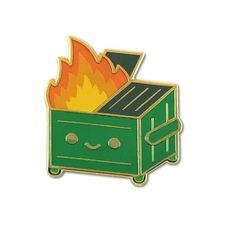 Class A fire: ordinary trash fire, dumpster fire. Flammable materials include bills, marked-up novel manuscripts, bureaucratic paperwork, annoying ordinary things gone wrong. Extinguish with water, monoammonium phosphate, class A extinguisher. Don't take things personally, pay the bills, sign the papers, put it behind you.
Class A fire: ordinary trash fire, dumpster fire. Flammable materials include bills, marked-up novel manuscripts, bureaucratic paperwork, annoying ordinary things gone wrong. Extinguish with water, monoammonium phosphate, class A extinguisher. Don't take things personally, pay the bills, sign the papers, put it behind you.
Class B fire: flammable liquids and gas fires. Drama, fighting, tantrums. Do not give histrionic people more fuel or water, which will only increase their surface area. Cover with a blanket. Class B extinguisher. Walk away and do not engage.
Class C fire: electrical fire. Sometimes the (internet, human) connection is like an addiction, and rumors, gossip and obsessions do more harm than good. Facebook Insta Snap Tweet Tinder. Unplug; cut off power source. Do not use water.
Class D: combustible metal. Dry powder will smother and absorb heat. Also, if your car is smoking, maybe it's time to evacuate, or at the very least, call the car garage.
Class K: cooking fire. Wet chemical fire extinguisher. Less multitasking reduces risk of burning food/the kitchen to the ground.
 Class A fire: ordinary trash fire, dumpster fire. Flammable materials include bills, marked-up novel manuscripts, bureaucratic paperwork, annoying ordinary things gone wrong. Extinguish with water, monoammonium phosphate, class A extinguisher. Don't take things personally, pay the bills, sign the papers, put it behind you.
Class A fire: ordinary trash fire, dumpster fire. Flammable materials include bills, marked-up novel manuscripts, bureaucratic paperwork, annoying ordinary things gone wrong. Extinguish with water, monoammonium phosphate, class A extinguisher. Don't take things personally, pay the bills, sign the papers, put it behind you.Class B fire: flammable liquids and gas fires. Drama, fighting, tantrums. Do not give histrionic people more fuel or water, which will only increase their surface area. Cover with a blanket. Class B extinguisher. Walk away and do not engage.
Class C fire: electrical fire. Sometimes the (internet, human) connection is like an addiction, and rumors, gossip and obsessions do more harm than good. Facebook Insta Snap Tweet Tinder. Unplug; cut off power source. Do not use water.
Class D: combustible metal. Dry powder will smother and absorb heat. Also, if your car is smoking, maybe it's time to evacuate, or at the very least, call the car garage.
Class K: cooking fire. Wet chemical fire extinguisher. Less multitasking reduces risk of burning food/the kitchen to the ground.
Published on February 28, 2019 12:51
February 21, 2019
4.6. Ship of Fools
In the Middle Ages, people with mental illness were sent off into the open sea in a sailing boat to search for their lost rationality.
The ship of fools is a Bosch painting, the title of several songs, and the name of a few modern films. In The Republic, Plato describes a gang of foolish sailors who take possession of a ship, chain up the captain and throw people they don't like overboard. More interesting, perhaps, is Foucault's discussion of Narrenschiff, ship of fools, in Madness and Civilization, as the symbol of the (changing) status of madness.
Madness was fascinating because it was unknown, and the "madman" seemed to possess some kind of forbidden knowledge that related to the end of the world. Madness, like death, was a mystery, and in a religious era, that also became linked to the theme of apocalypse.
That's what Bird Box was about, right? That maybe "mad" people aren't actually mad, but are the only ones who saw the truth this entire time, and we are fools on a ship or blind people in a cave who chemically restrain them with haldol-benadryl-ativan, give them a diagnosis from the Diagnostic and Statistical Manual of Mental Disorders (DSM-5) and silence them. If we only saw what they've been seeing their entire lives, we'd instantly develop suicidal ideation, a lethal plan, and carry it out.
Foucault describes the classical period (couple centuries after the Middle Ages and a couple centuries before us) as being more tolerant towards madness than our modern times, and this seems fair. While we are all just one (really awful) trigger away from full-blown mental illness, our society marginalizes psych patients in locked facilities while cheerfully using them as plot devices (or to just scare people really bad) in popular entertainment. They're in ships that don't sail, in stories that aren't real.
The truth is, most of us folk without psych diagnoses are lost at sea quite a lot of the time, too. We cope, is all.
And denial's a beautiful thing.
 Bosch's Ship of Fools
Bosch's Ship of Fools
The ship of fools is a Bosch painting, the title of several songs, and the name of a few modern films. In The Republic, Plato describes a gang of foolish sailors who take possession of a ship, chain up the captain and throw people they don't like overboard. More interesting, perhaps, is Foucault's discussion of Narrenschiff, ship of fools, in Madness and Civilization, as the symbol of the (changing) status of madness.
Madness was fascinating because it was unknown, and the "madman" seemed to possess some kind of forbidden knowledge that related to the end of the world. Madness, like death, was a mystery, and in a religious era, that also became linked to the theme of apocalypse.
That's what Bird Box was about, right? That maybe "mad" people aren't actually mad, but are the only ones who saw the truth this entire time, and we are fools on a ship or blind people in a cave who chemically restrain them with haldol-benadryl-ativan, give them a diagnosis from the Diagnostic and Statistical Manual of Mental Disorders (DSM-5) and silence them. If we only saw what they've been seeing their entire lives, we'd instantly develop suicidal ideation, a lethal plan, and carry it out.
Foucault describes the classical period (couple centuries after the Middle Ages and a couple centuries before us) as being more tolerant towards madness than our modern times, and this seems fair. While we are all just one (really awful) trigger away from full-blown mental illness, our society marginalizes psych patients in locked facilities while cheerfully using them as plot devices (or to just scare people really bad) in popular entertainment. They're in ships that don't sail, in stories that aren't real.
The truth is, most of us folk without psych diagnoses are lost at sea quite a lot of the time, too. We cope, is all.
And denial's a beautiful thing.
 Bosch's Ship of Fools
Bosch's Ship of Fools
Published on February 21, 2019 10:16
February 13, 2019
4.5. EKG = electrocardiogram
Because studying all the abnormal heart rhythms is giving us paroxysmal supraventricular tachycardia, here're some EKG poems instead.
V-Fib
The dangerous valentine’s fib
what she saw-
toothed electrical chaos
hogging oxygen
no output
rapidly fatal to relationship in
3-5 minutes
faint pulseless apneic
no blood pressure
absent heart
acidosis
seizures
fixed, dilated pupils
cold, mottled skin
defibrillate--
won't work if heartless tho

Ventricular Asystole
Standstill
no impulses left
no depolarization QRS contraction
only P
sometimes not even that
electrical silence
inadequate cerebral perfusion oxygenation
unconscious
after cardiac arrest comes respiratory arrest
resuscitation
CAB it but
don’t shock
don’t shoot
implantable converter
no magnet
vest that if conscious
press button to prevent shock
otherwise a donkey’s kick to chest
Versed
Verse
V
V-Fib
The dangerous valentine’s fib
what she saw-
toothed electrical chaos
hogging oxygen
no output
rapidly fatal to relationship in
3-5 minutes
faint pulseless apneic
no blood pressure
absent heart
acidosis
seizures
fixed, dilated pupils
cold, mottled skin
defibrillate--
won't work if heartless tho

Ventricular Asystole
Standstill
no impulses left
no depolarization QRS contraction
only P
sometimes not even that
electrical silence
inadequate cerebral perfusion oxygenation
unconscious
after cardiac arrest comes respiratory arrest
resuscitation
CAB it but
don’t shock
don’t shoot
implantable converter
no magnet
vest that if conscious
press button to prevent shock
otherwise a donkey’s kick to chest
Versed
Verse
V
Published on February 13, 2019 09:35
February 7, 2019
4.4. BLS Algorithm = Make Your Own Adventure
The theme song to this post is Stayin' Alive, at about 100 beats per minute, the recommended rhythm for high quality chest compressions.
Well, you can tell by the way I use my walk
I'm a nursing student, no time to talk
Bed alarms loud and bedpans warm
Answering call lights since 6:30 this morn
And now it's all right, it's okay
And you may look the other way
We can try to understand
CPR's effect on man
Whether you're a student or whether you're a patient
You're stayin' alive, stayin' alive
Feel the epi pushin' and people compressin'
And we're stayin' alive, stayin' alive
Ah, ha, ha, ha, stayin' alive, stayin' alive
Ah, ha, ha, ha, stayin' alive
Code Blue somewhere, somebody help me
Somebody help me, yeah
Life goin' nowhere, somebody help me, yeah
I'm stayin' alive
The Basic Life Support & Advanced Cardiac Life Support algorithms are probably some of the darkest flow charts available outside of those old Make Your Own Adventure books and Netflix's new interactive film, Bandersnatch, but nobody's going to give you a 50 question test on "chop or bury?" "get rabbit," or "red door, turn to page 55."
No pulse? Chest compressions. No breathing? Ventilate. Neither? 30 compressions per 2 breaths. Shock VF VT, don't shock PEA Asystole. CPR, Epinephrine, shock, Amiodarone, rinse & repeat until patient's back or the doctor calls it. Put everything into those compressions because we really don't want her to call it.
The basic flow chart of all our lives inevitably ends in death. Why bother? Because what matters isn't the end result, but everything that happens in between. Life is short--let's make this count.

Well, you can tell by the way I use my walk
I'm a nursing student, no time to talk
Bed alarms loud and bedpans warm
Answering call lights since 6:30 this morn
And now it's all right, it's okay
And you may look the other way
We can try to understand
CPR's effect on man
Whether you're a student or whether you're a patient
You're stayin' alive, stayin' alive
Feel the epi pushin' and people compressin'
And we're stayin' alive, stayin' alive
Ah, ha, ha, ha, stayin' alive, stayin' alive
Ah, ha, ha, ha, stayin' alive
Code Blue somewhere, somebody help me
Somebody help me, yeah
Life goin' nowhere, somebody help me, yeah
I'm stayin' alive
The Basic Life Support & Advanced Cardiac Life Support algorithms are probably some of the darkest flow charts available outside of those old Make Your Own Adventure books and Netflix's new interactive film, Bandersnatch, but nobody's going to give you a 50 question test on "chop or bury?" "get rabbit," or "red door, turn to page 55."
No pulse? Chest compressions. No breathing? Ventilate. Neither? 30 compressions per 2 breaths. Shock VF VT, don't shock PEA Asystole. CPR, Epinephrine, shock, Amiodarone, rinse & repeat until patient's back or the doctor calls it. Put everything into those compressions because we really don't want her to call it.
The basic flow chart of all our lives inevitably ends in death. Why bother? Because what matters isn't the end result, but everything that happens in between. Life is short--let's make this count.

Published on February 07, 2019 16:48
February 1, 2019
4.3. Circles of Trust
Intimate distance is 0-18 inches, personal distance 18-40 inches, social distance 4-12 feet, and public distance more than 12 feet. But that's just physical space.
The tricky kind of space, with invisible walls erected all the way to the clouds, hidden bear traps and quicksand that surprise visitors, and boundaries that crumble when they're most needed--that's all metaphor.
Whose negative words do you let in when you shouldn't? Who should you reach out to more? Whom should you hold close? (This is becoming a terrible who/whom grammar exam.) If Kevin no longer sparks joy, but instead incites murderous rage or brings endless dilute tears, maybe he needs to go out with the other boxes of stuff you Marie Kondo-ed to the Goodwill.
In a world of strangers, room full of acquaintances, lifetime of relationships come and gone, how many people remain in your inner circle of trust? Two? Three? Now that one has died and is forever watching over you, how many remain?
You are Freud's iceberg with only the tip of the ego showing; Jung's shadow/self, anima/animus. You are a star system. That sun in the middle? You.
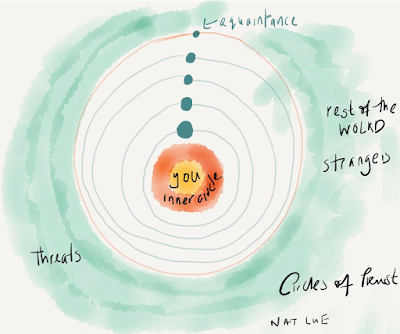
You galaxy is your circles of trust. From your point of view, you are always the center, not because you're egocentric, but because you must take control of and responsibility for who you let in, whom you say no to, whom you give precious time to. It's difficult, but it's okay to say no. Every single time.
Maybe you let someone in, and they disappointed you so utterly they have to be banished to the outskirts of your orbit. Perhaps you love certain people and they love you, but if they are a bad influence, out of your galaxy they go. Some people are jealous, negative, envious, dishonest, and cannot be trusted to stay anywhere close to your center because negative energy is far more contagious than resistant bacteria or cold and flu viruses.
On the other hand, your center must be strong with you alone in it, too. One's happiness cannot depend on others. It's enough work fighting off all the unhappiness in the world. Regardless of what Yeats says, the center must hold.
The tricky kind of space, with invisible walls erected all the way to the clouds, hidden bear traps and quicksand that surprise visitors, and boundaries that crumble when they're most needed--that's all metaphor.
Whose negative words do you let in when you shouldn't? Who should you reach out to more? Whom should you hold close? (This is becoming a terrible who/whom grammar exam.) If Kevin no longer sparks joy, but instead incites murderous rage or brings endless dilute tears, maybe he needs to go out with the other boxes of stuff you Marie Kondo-ed to the Goodwill.
In a world of strangers, room full of acquaintances, lifetime of relationships come and gone, how many people remain in your inner circle of trust? Two? Three? Now that one has died and is forever watching over you, how many remain?
You are Freud's iceberg with only the tip of the ego showing; Jung's shadow/self, anima/animus. You are a star system. That sun in the middle? You.

You galaxy is your circles of trust. From your point of view, you are always the center, not because you're egocentric, but because you must take control of and responsibility for who you let in, whom you say no to, whom you give precious time to. It's difficult, but it's okay to say no. Every single time.
Maybe you let someone in, and they disappointed you so utterly they have to be banished to the outskirts of your orbit. Perhaps you love certain people and they love you, but if they are a bad influence, out of your galaxy they go. Some people are jealous, negative, envious, dishonest, and cannot be trusted to stay anywhere close to your center because negative energy is far more contagious than resistant bacteria or cold and flu viruses.
On the other hand, your center must be strong with you alone in it, too. One's happiness cannot depend on others. It's enough work fighting off all the unhappiness in the world. Regardless of what Yeats says, the center must hold.
Published on February 01, 2019 10:00



